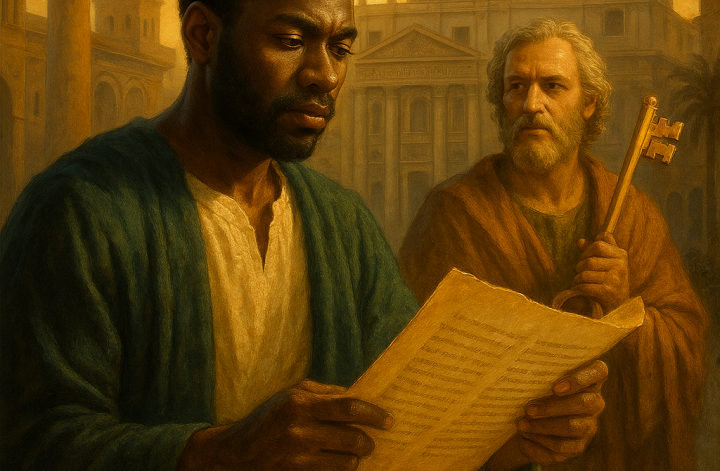Having addressed the cultural background of Jesus’ time and the ubiquitous physiognomic awareness recorded in the Hebrew Bible (See Part 1), we are now ready to look into relevant New Testament data. Our minds may have been so thoroughly clogged by the image of a White Jesus that we may be shocked to learn that the Bible says nothing that may help anyone visualize what the historical Jesus might have looked like. Though New Testament writers often portray Jesus as a type of Moses, not a single writer mentions Jesus’ physical trait like Exodus does with Moses. Consider the Gospel of John, for instance. Although John explicitly links Moses and Jesus when he says, “For the law was given through Moses; grace and truth came through Jesus Christ” (1:17), he says nothing about the physical form of Jesus. Instead, we get this verse: “The Word became flesh and made his dwelling among us. We have seen his glory, the glory of the one and only Son, who came from the Father, full of grace and truth” (1:14). As Joan Taylor remarks, “this does not immediately conjure up an image of a specific person who could be described in terms of height, facial features, handsomeness, beardedness, clothing, or whatever” (2).
John is not alone in side-stepping baby Jesus’s physical attributes. Matthew and Luke are also guilty. Mark does not even bother to tell the story of the birth of Jesus. Here is what Matthew says about the baby: “On coming to the house, they saw the child with his mother Mary, and they bowed down and worshiped him. Then they opened their treasures and presented him with gifts of gold, frankincense, and myrrh.” (Matthew 2:11) Not much was said about the baby. All we are told is that the company of Magi presented the baby with gifts.
Luke has a few lines devoted to telling about the baby. First, he writes in 2:6-7 that “While they were there, the time came for the baby to be born, and she gave birth to her firstborn, a son. She wrapped him in cloths and placed him in a manger because there was no guest room available for them.” Of course, once again, nothing here is specific to the appearance of the baby (compared to baby Moses being a beautiful baby, Exodus 2:2, for instance). Next, he points out that certain shepherds “hurried off and found Mary and Joseph, and the baby, who was lying in the manger. When they had seen him, they spread the word concerning what had been told them about this child” (Luke 2:16-17). It is as though the baby was very ordinary in form despite its unordinary birth circumstances.
We do not have useful information on the adult Jesus either. The data on Jesus’ physical attributes are even much more interesting post-resurrection as his bodily form becomes, as Taylor observes, “a curiously unstable category” (2). The Apostle John writes that Jesus “was in the world, and though the world was made through him, the world did not recognize him. He came to that which was his own, but his own did not receive him” (John 1:10-11). Remarkably, after the resurrection, even the disciples closest to Jesus would not recognize him by his bodily form alone.
Consider the following famous account of Mary of Magdala’s encounter with the risen Jesus in John 20. Having discovered that Jesus’ body was missing, Mary stayed at the tomb weeping. Then she saw two angels seated Jesus’s length apart who asked why she was crying. She explained that her master’s dead body was missing. Then, John writes that “At this, she turned around and saw Jesus standing there, but she did not realize that it was Jesus” (John 20:14). Jesus stood right in front of Mary Magdalene, but she did not recognize him. Is she, like everyone else, not expecting an executed man to come back to life? Did Jesus look slightly different from she was familiar with? The text does not say. What we know is that Mary did not recognize Jesus from a close range. We have often explained this away by alluding to Mary’s overwhelming grief having the better of her and dimming her perception. While this explanation certainly has some merit—after all, great sorrow would overwhelm Mary and all who loved Jesus—it fails when all relevant data are taken together as we shall see shortly.
The motif of the unrecognizability of the risen Jesus in John’s Gospel is even more staggering in the epilogue. Here, seven disciples went fishing by the sea of Galilee. They were psychologically functional enough to go fishing. Then, “early in the morning, Jesus stood on the shore, but the disciples did not realize that it was Jesus” (John 21:4). He asks the disciples if they have any fish to which they answered, “no.” Then, Jesus instructs these men, including Simon Peter, on how to get a catch—completely reminiscent of how Peter met Jesus. The disciples obeyed and, like it once happened, they caught much fish. At this, John uttered, “It is the Lord!” (John 21:7). And after the disciples caught up with Jesus, we read (John 21:12-14):
Jesus said to them, “Come and have breakfast.” None of the disciples dared ask him, “Who are you?” They knew it was the Lord. Jesus came, took the bread and gave it to them, and did the same with the fish. This was now the third time Jesus appeared to his disciples after he was raised from the dead.
As he does in the previous chapter, John inserts a natural device (“early in the morning”—that is, before sunrise) into this narrative, perhaps to serve as a plausible explanation for the unrecognizability. But this cannot be a satisfying, ultimate explanation. Suppose the dim conditions of light initially prevented them from recognizing Jesus. Why would they still have the doubts expressed in 21:14, being so near to Jesus? Also, notice that “the disciple whom Jesus loved” only recognized Jesus by his miraculous deed—not by his voice, look, or any personal physical trait. Indeed, the line, “None of the disciples dared ask him, ‘Who are you?’ They knew it was the Lord” seems to highlight the point that the disciples’ recognition of Jesus was not by any physical trait (alone?). It is as though John subtly asserts that knowing the resurrected Jesus would no longer be through personal physical attributes.
In addition, John’s portrayal of Thomas’s encounter with Jesus further supports the claim that people would only truly know the resurrected Jesus through non-physical personal means. Jesus had once appeared to the disciples, but Thomas was missing. So, when the others told him they had seen the risen Lord—with no physical descriptions by the way—Thomas answered for a lot of believers today when he said, “Unless I see the nail marks in his hands and put my finger where the nails were, and put my hand into his side, I will not believe” (John 20:25). In the following week, Jesus reappeared to a group of the disciples including Thomas, and he led with a line showing his knowledge of Thomas’ criteria for believing, “Put your finger here; see my hands. Reach out your hand and put it into my side. Stop doubting and believe.” (John 20:26). In response, Thomas acknowledged Jesus as Lord and God (John 20:28). Then, John wraps up the story with this comment, “Then Jesus told him, ‘Because you have seen me, you have believed; blessed are those who have not seen and yet have believed” (John 20:29). Though this verse referred to First Century followers who believed in the risen Jesus, it is also likely that John meant for this verse to apply to people who would later believe as well. It is worth reiterating that no meaningful data on Jesus’ physical features are provided in these narratives.
John is not alone in exploring this “unstable category” of Jesus’ post-resurrection body. In fact, what John does subtly, Luke and Mark do as-a-matter-of-factly. In Luke 24, a story is told about two disciples of Jesus who were on the road to Emmaus. These disciples were close to Jesus and would have known what their Rabbi looked and sounded like; the foremost 11 disciples also knew these guys (Luke 24:33). Jesus appeared to these two disciples and joined them on a 7-mile (and roughly 2 hours) journey on foot, expositing scriptures and conversing with these disciples. Yet, the disciples noticed nothing familiar in the voice or look of Jesus because “they were kept from recognizing him” (Luke 24:16). How exactly were they kept from recognizing Jesus? The contested longer ending of Mark 16 simply says Jesus took on a different form (16:12). So, there was nothing wrong with the disciples’ cognitive faculties. Indeed, the moment they recognized Jesus through his act of breaking the bread and the inner witness of “burning hearts” (Luke 24:33), he vanished. Once again, we have no useful data here that an artist might use to paint Jesus. Taylor writes, “No one is told what the original form of his body was, or what the other form looked like” (4).
As Taylor further observes, the author of the book of Hebrews also avoids giving details about Jesus’ bodily attributes. Hence, though Hebrews says that Jesus had a body (2:14), it says nothing about what it looked like. The book further mentions that as a human, Jesus had to learn obedience through the things he suffered (5:7-8), yet nothing more specific is provided. Hence, Taylor writes, “We have explicit mention of Jesus’ tears. But still we do not learn of the fleshly face of Jesus those tears ran down” (4).
So, given that the bible is conspicuously lacking in any details on what Jesus looked like, how did White Jesus come into existence? White Jesus imagery had a pious and benign origin. Precisely because of a scarcity of useful information on what Jesus looked like, Europeans imagined him in their own images. “Over the centuries in European art,” Taylor writes, “it was common to depict Jesus in line with the models available in the artists’ communities: a Dutch artist therefore portrayed a Dutch Jesus, an Italian one presented an Italian” (15). This is commendable. Indeed, I think more and more believing African Christians should portray Jesus in whatever forms they can relate to. Nothing here is theologically problematic provided that “this is not actually meant to show what Jesus looked like in real life” (Taylor, 15). With European imperialism and colonization, however, an idealized White Jesus transformed from a mere European cultural invention to being the ontological and true Jesus. There was no longer any other Jesus but the White Jesus.
European missionaries took their beloved white Jesus with them everywhere they went. Of course, the White Jesus imagery is only a tiny but powerful part of European colonizing enterprise. Missionaries also imposed – not unusually, by violence – everything that was at the time normative for them as the Christian ideal. All that did not align with this European ideal was demonized. Hence, Africa’s traditional marriage (polygamy versus monogamy) and wedding (White “Church” wedding versus equally legitimate traditional forms), for instance, were demonized. As we shall see in Part 3, the seeds of racism sown by European missionaries are still germinating even in the supposedly homogenous African States and churches.
Work Cited
Taylor, Joan E. What Did Jesus Look Like? Bloomsbury Publishing Plc, 2018.





2 Comments
Consider leaving a comment. Tell us what you like, disagree with, or whatever. Look out for the next installment.